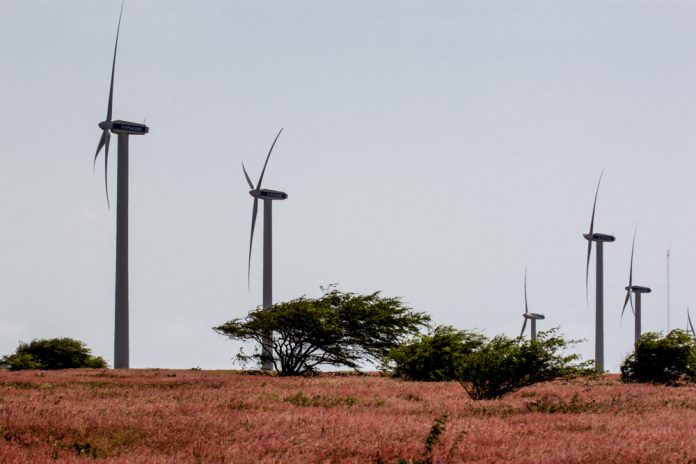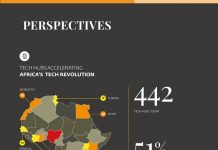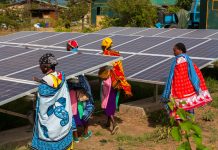The 10-island nation of Cape Verde, off Africa’s west coast, is making lots of noise when it comes to renewable energy, largely due the success of its wind energy company, Cabeólica S.A.
Recently named one of the best public-private partnerships in emerging markets by the World Bank’s International Financial Corp., Cabeólica is also a 2013 winner of the Ashden Award, the world’s leading prize for green energy. In 2011 it won the Best Renewable Project in Africa Award at the Africa Energy Awards in Johannesburg, South Africa.
“The rate at which Cape Verde has achieved such a high proportion of wind power in its electricity mix is truly staggering. It is showing other resource-stretched small islands around the world what can be achieved, where there’s a will,” the Ashden judging panel said.
Wind power is a natural for Cape Verde, which lies in the path of the northeasterly trade winds and consistently experiences high-speed winds. The government’s push is aimed at reducing both the country’s dependence on imported diesel to power its electricity supply and the high cost of generating electricity, which keeps prices high for consumers.
“Because we are poor in natural resources and because of our island location, Cape Verde has no way of getting our energy cheaply. So wind energy is the best solution,” says Ana Monteiro, head of Cabeólica’s Environment, Social and Administrative Department. “Cape Verde had great wind. It is strong and mono-directional, which is great for wind energy production. And the wind is constant. Wind energy is less expensive than solar, for one reason is that wind can blow 24 hours a day.”
The first grid-connected wind turbines were introduced in Cape Verde in 1994, but they produced no more than 2 percent of energy needs. Initiated by the government, Cabeólica entered the scene in 2009, with the Africa Finance Corp. and the Finnish Fund for Industrial Cooperation (Finnfund) coming on board as majority shareholders in 2010. Other shareholders are Electra, Cape Verde’s national electric utility, and InfraCo Ltd., a donor-funded infrastructure development company.
“There must be at least one year of on-site wind data to build a project like this, and this is what had to be collected in order to get investors interested,” says Monteiro, a former consultant for InfraCo.
During Cabeólica’s first year of operation, four wind farms, totaling 25.5 mega watts of installed capacity, generated more than 20 percent of the electricity used on the four islands with the highest demand: Santiago, where the capital and the main commercial areas are located; São Vicente, the former industrial hub and main port; and Sal and Boa Vista, the main tourist destinations. The company says it can build farms on all of Cape Verde’s nine inhabited islands, but energy consumption on the lesser-populated islands currently is too low to justify investment in large-scale projects.
Construction of the first wind farm began in 2010 and the farm started generating in 2011. The last farm was completed in mid-2012. The four farms produced 61.6 million kilowatts of power in 2012, saving imports of an estimated 20 million liters of fuel oil and diesel for the year.
According to Ashden’s case study, during the 12 months from April 2012 to March 2013, when all except one were operating at full capacity, the wind farms generated 64,000 megawatt hours, which is 21 percent of the electricity distributed by Electra on the four islands, or around 18 percent of the total supply to Cape Verde. On São Vicente and Sal islands, the average exceeds 30 percent. Cabeólica’s wind farms were the main driver in Cape Verde’s achievement of 25 percent renewable energy penetration in its national grid.
“It is impressive to have achieved this high percentage use of wind within such a short time. The only country t achieve more than this is Denmark (28 percent in 2011), but it has built up the use of wind much more gradually,” Ashden says.
Wind energy also has curbed around 70,000 tons of greenhouse emissions to date, says Monteiro. But much more work has to be done, including changing the public’s perception of renewable energy, she says.
“There is a lot of misinformation and some of the general public wind power is more expensive, when the opposite is true. It was expensive for us to build the four wind farms, which we had to do because each island has isolated electrical grid. If there was one grid, we could build one farm and supply power to all the islands that way,” Monteiro says, adding that the company also had to bring in specialized equipment and people with the know-how to get the project up and running.
“But when it comes to the costs of the power we generate, the utility company has less costs when purchasing our power than it does in producing through the conventional method, thus lowering the electricity production cost,” she says.
Monteiro sees the wind farm project eventually producing 30 percent of Cape Verde’s energy needs. “But since we are [technically] still in our first year of operation, we are tweaking things, figuring out what works best, hiring personnel and trying to utilize new methods that will maximize wind penetration,” she says.
Even so, Cabeólica is becoming a globally recognized name for the work it has already accomplished. “We have people from all over the world looking at us as a model for other wind projects,” affirms Monteiro.













